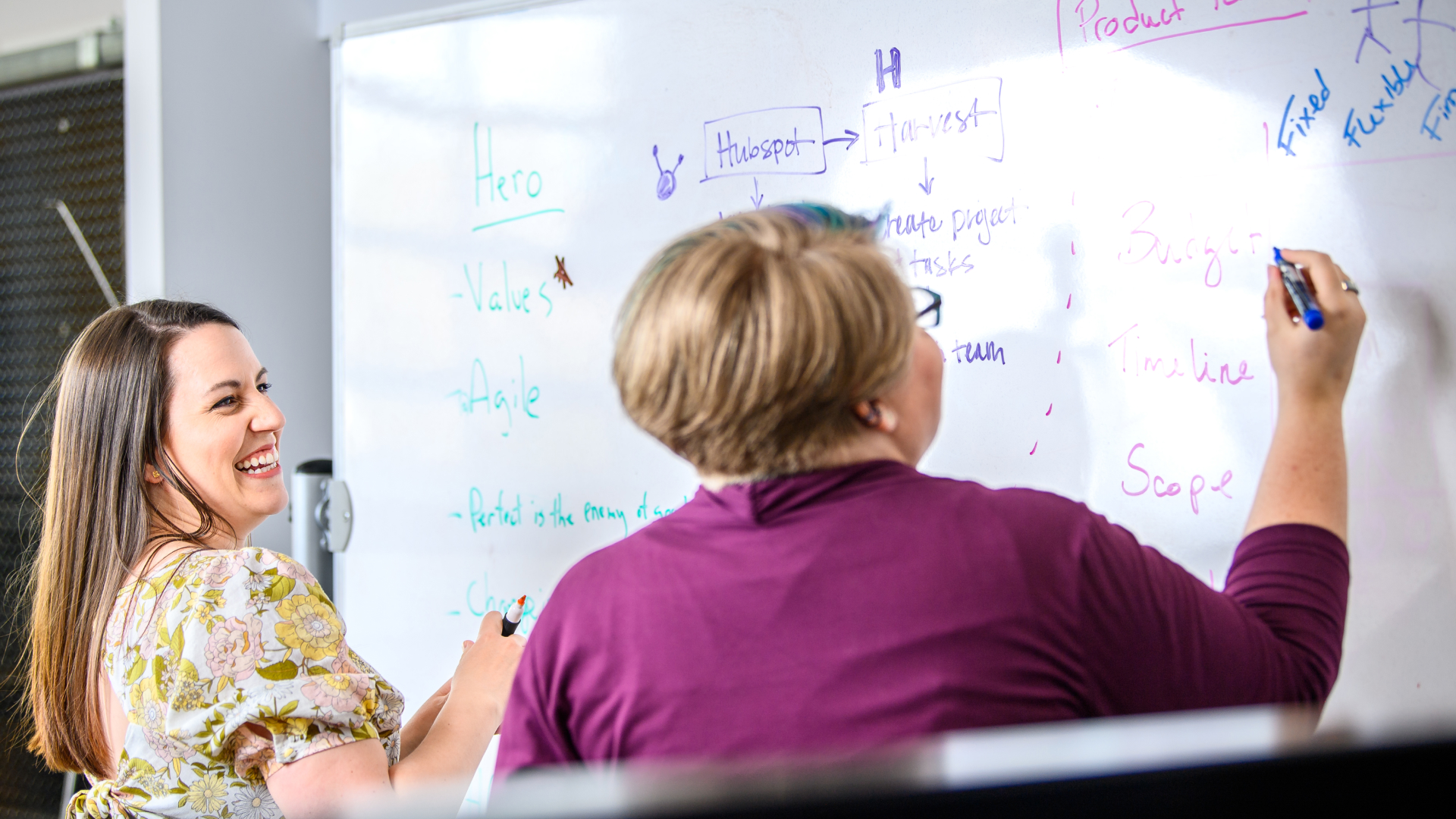Is experience design the same as visual design? No. Is it user experience (UX)? No!
The core meaning of experience design can be found in the name itself: It is an approach that centers on people’s experiences to drive the design and features of your products, processes, environments, and strategies. Experience design draws on users’ needs, feelings, contexts, and mindsets to design experiences that center on them.
Experience design covers a broad spectrum of interactions between businesses and their users. These can range from everyday transactions like purchases and customer support to more specialized encounters such as new product launches, interactive retail displays, or informational websites. It also extends to internal business tools like intranets and analytics dashboards. Each of these touchpoints offers businesses an opportunity to enhance the user experience, whether it’s for customers, clients, or employees.
But it’s also more than that: experience design can be a business strategy. It provides a lens for practical and innovative problem-solving to address business and user challenges. Many disruptors, like Airbnb and Warby Parker, burst onto the market and found strong footing because they focused on user experience when developing their businesses.
For example, Lyft and other ride-sharing companies recognized that users didn’t want to wait for the driver to swipe their credit card (or gamble if they’d even accept their credit card at all) and didn’t want to have to call to arrange a pick-up. So, they focused on what customers did want — ease, convenience, speed — and created a new approach. And a very successful one at that.
Why is experience design important?
Designing an experience means more than making the life of your customer easy or delightful (which are common and vague “user-centered” goals), it means shaping the way the customer feels. Easy isn’t great if it leaves the customer feeling un-secure — like, maybe it’s too easy to buy that app in the app store? And delightful isn’t great if the customer can’t find the one button they’re looking for — oh, it’s hidden behind that ultra-cool graphic popup?!
The bottom line is that no matter how much you prioritize it (or not), your customers will have an experience with your service, product, or brand. Every web page, every social media interaction, every single piece of software that is needed to take them from point A to point Z will elicit an emotion — what that emotion is, is (mostly) entirely up to you.
Quality experience design means every single interaction is well considered, and all of it has to be coordinated and strategically implemented to be consistent. From the packaging to the mobile app, every touch point is an opportunity to convey the vision of your experience design (XD).
If you practice Experience Design, you’re no longer focusing on just the product but the experience as a whole. You’re literally selling an experience.
What to think about when it comes to designing experiences
To keep things simple, there are a few main components to keep in mind when understanding customer experience design.
Human-centered thinking is a requirement
Experiences require every detail and moment to be centered on the person. That means shifting your thinking from “what can we build?” to “what do people want and need?”
A good real-life example of this is a small UX decision my bank made with their mobile app. As a customer, I use the app to basically do just two things: check my balance and deposit checks. They’ve used human-centered thinking to anticipate my needs, and front and center on the main screen is my balance, and a big button to “deposit check.” It’s a relatively small thing, but it suggests that they asked themselves, “Why are people using the mobile app? What are they trying to accomplish and how can we make it easy for them?” Of the 20+ menu items that appear on the desktop version, they designed their mobile experience to reflect their customers’ mobile need: to easily check their balance and deposit checks.
Knowing your users, listening to their needs, considering their contexts and environments — these are all ways to move experience to the center of your products.
When you design experiences, not features, it affects your whole business
Centering on customers, not your business or product, will likely impact how your entire organization works — and most notably, your internal culture. A recent Harvard Business Review article states, “the most common, and perhaps the greatest, barrier to customer centricity is the lack of a customer-centric organizational culture.”
Decisions that were once siloed will require a more holistic approach. What was once a marketing problem is reframed as a staff-wide problem because experiences are department-agnostic.
In the old model, the marketing department might have “increase orders” as an annual goal. But in the new model — one centered on experiences — the goal would be something like “shorten the time between an online order and the moment it arrives on a customer’s front porch” because they learned that lengthy ship time was the biggest customer pain point. That goal requires a much different organizational approach: The marketing team (who are in charge of increasing cart orders) must work collaboratively with fulfillment and operations (who are in charge of shipping time) to improve the customer experience.
The thing to remember is that customers don’t know, or care about, your organizational structure or culture. They care about themselves, so if you’re going to care about them, too, then you will likely need to change how everyone internally works. No matter the intention, your internal culture is reflected in your external experiences.
Your technology choices matter
Designing a great experience is about more than what you — or your customers — can see. It might be easy to see how navigation menus, workflows, and search filters can impact your users’ experience, but the underlying foundation is just as important.
The technology that powers those menus and features is crucial to all aspects of what users experience.
- Will it be fast and efficient? If your technology is slow, users will use something else.
- Will it allow you to design and build the features and interactions you need in flexible ways? Your customers’ needs and wants can change quickly.
- Will you be able to gather the data you need to make user-centered decisions? Understanding your users is an ongoing project that requires tools.
The key takeaway is that experiences are driven by design and technology. When the two things aren’t in sync, you get experiences that are neither user-centered nor feature-centered. But when the two work together, it can turn customers into brand evangelists.
Use data to make decisions by testing and iterating
Great experiences are one part human-driven and one part data-driven. They are achieved qualitatively and quantitatively. Why? Because humans are pretty bad at knowing what they want.
Designing experiences that accomplish goals is not easy. To be truly effective, every experience must be user-centered and get your business what it needs. That’s where testing and iterating can help. And the results, the data, allow you to validate assumptions, preferences, and actions.
Once you know what you want to accomplish, you can break down the many ways you might accomplish it. Then test each of those things. Everything — from language to colors to audio styles — are testable, and can impact what users do with the task at hand.
By building the concepts of testing and iterating into your process from the start, you save time and effort and improve your chances of success. And while it won’t tell you everything you need to know, the right data can help you make decisions that create amazing experiences.
Create experiences for everyone
Whether you call it accessibility or inclusivity, one thing is certain: you should be designing for all customers. Not only does 20% of the population have some type of cognitive, physical, visual, or auditory disability, the rest of us are only temporarily abled. I could break a leg, have an accident, or lose some vision or hearing capabilities at any time. And I am definitely going to age and lose some abilities as that happens.
One of the other big reasons to take an inclusive design approach is that the outcome is actually better for everyone. It’s universal. This is also why accessible and inclusive design is sometimes called universal design.
Use experience design as a competitive advantage
Investing in the experiences you’re designing can improve your business. McKinsey & Company found a correlation between the McKinsey Design Index rankings and business performance. And, consumers are eager for more direct and meaningful interactions with brands. That all comes down to design and making experiences, not products or technology or features.
Let us help you develop a competitive advantage by building memorable experiences. Get in touch.




